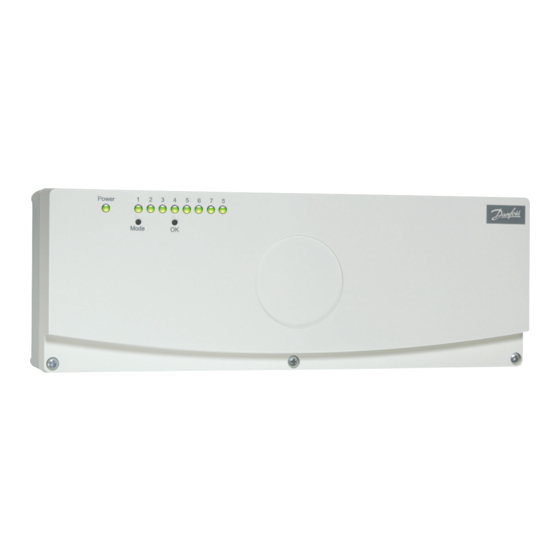- ページ 5
サーモスタット Danfoss FH-RTのPDF 据付・取扱説明書をオンラインで閲覧またはダウンロードできます。Danfoss FH-RT 6 ページ。 Wireless room thermostat and wireless base unit

If no signal is received from one or more thermostats, the corresponding
LEDs on the indicator panel remain lit.
When the required number of thermostats have been checked, press and
hold "MODE" for 3 seconds to return the system to normal mode.
Note: The system returns automatically to normal mode if no buttons are
pressed during a 15-minute period.
5.3 Thermostat test mode
This mode is used to test thermostat transmission.
Using the point of a pencil or similar, press and hold the transmission button
on the front of the thermostat for 3 seconds.
This forces the thermostat to transmit a signal every 7 seconds for 5-6
minutes.
Then check whether a signal from the thermostat is received by the base
unit at 7 second intervals (the LED indicator for the assigned channel flashes
on receiving a signal).
The test can be terminated by again pressing the thermostat transmission
button.
Note: The system returns automatically to normal mode if no buttons are
pressed during a 5-minute period.
5.4 Thermal actuator output testing
Thermal actuator output testing is used to check the functioning of the base
unit output relays.
Press and hold the "MODE" button for 3 seconds (all LED indicators flash).
The first indicator then begins flashing.
Press "OK" to test the first channel. The LED indicator now flashes rapidly
(on/off at half-second intervals) and a small click can be heard after about 5
seconds indicating that the output has been activated. Press "OK" again to
de-activate the output.
Press "MODE" to select the next output to be tested, and repeat the process
described above.
The test can be terminated by pressing and holding the "MODE" button for
3 seconds.
Note: The system returns automatically to normal mode if no buttons are
pressed during a 10-minute period.
5.5 Alarm function
This function is initiated automatically in case of communication failure.
If the base unit does not receive a signal from a registered thermostat for 2
hours, the corresponding LED indicator starts flashing. Simultaneously, the
thermal actuator output begins a continuous cycle of 7 minutes' activation
and 14 minutes' de-activation.
Fig. 7. Switches
If after a further 8 hours the base unit has still not received a signal from the
thermostat, an acoustic alarm begins buzzing. The buzzer can be de-activated
by selecting the alarm "OFF" setting on the base unit (see Fig. 9). The alarm
is reset when a button on the control panel is pressed or when the base unit
receives a signal from the thermostat.
5.6 Thermal actuator & pump exercise
This function prevents the manifold valve and circulating pump from
sticking.
It is activated once yearly. First, all assigned outputs are activated for 5
minutes, and the pump output is then activated for 5 minutes (only if pump
output is installed).
The function can be turned off by switching the EXERCISE switch to the OFF
position. (See Fig. 10).
5.7 NO/NC thermal actuator settings
This function allows "Normally Closed' (N/C) or "Normally Open" (N/O) thermal
actuators to be used.
Type is selected on the ACTUATOR switch (see Fig. 10).
5.8 "Cooling" mode
This mode allows thermostat signals to be inverted so that outputs are opened
when the temperature is above the desired temperature and closed when
below and is intended for use in cooling systems.
6.0 Boiler and pump interlock setting
As standard, outputs 7 and 8 are set to control thermal actuators.
However, output 7 can also be used to control a boiler via an ON/OFF signal,
and output 8 can be used to control a pump.
To enable a boiler or pump to be controlled, the system must be configured
as shown in Figs 8 and 9 respectively.
Note: If outputs 7 and 8 are not used for thermal actuators, the following
applies:
- LED indicators 7 and 8 light up when any other channel requires heat.
Fig. 9. Step 2. Bend left-hand jumper as illustrated.
5
